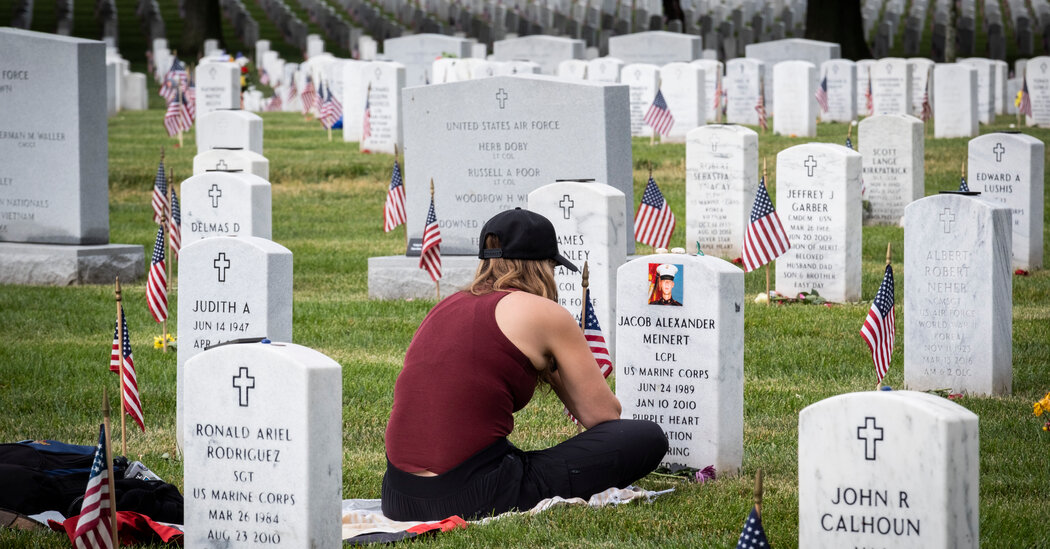Table of Contents
Memorial Day weekend is among the busiest for travel in the United States and the unofficial start of summer; a day for cookouts, beach trips and auto races. But how did Memorial Day, held on the last Monday of May in honor of America’s war dead, begin?
Here is a refresher:
Honoring the Civil War dead
The holiday grew out of the Civil War, as Americans — Northern, Southern, Black and white — struggled to honor the staggering numbers of dead soldiers, at least 2 percent of the U.S. population at the time. Several places lay claim to being the birthplace of Memorial Day. One of the earliest accounts comes from Boalsburg, Pa., where, in October 1864, three women are said to have placed flowers and wreaths on the graves of men who had died serving the Union during the Civil War.
In May 1865, just after the war ended, a large procession was held in the ruined city of Charleston, S.C. There, thousands of Black Americans, many of whom had been enslaved until the city was liberated just months earlier, commemorated the lives of Union captives buried in a mass grave at a former racecourse. The service was led by some 3,000 schoolchildren carrying roses and singing the Union marching song “John Brown’s Body.” Hundreds of women followed with baskets of flowers, wreaths and crosses, according to historical accounts.
Cities in the North and South began honoring their war dead. In May 1866, Waterloo, N.Y., was decorated with flags at half-staff, “draped with evergreens and mourning black,” according to the village. In Columbus, Miss., that same year, women were said to have placed flowers on the graves of both Confederate and Union soldiers.
What’s in a name?
Whatever its inception, historians agree that the first widely held commemoration was in 1868, when Gen. John A. Logan, the commander in chief of the Grand Army of the Republic, an organization of Union veterans, called for a national holiday to remember the Civil War dead. Their bodies, he said, lay in almost every city, village and churchyard.
May 30, Mr. Logan wrote in an order, should be “designated for the purpose of strewing with flowers or otherwise decorating the graves of comrades who died in defense of their country.”
For many years, the commemoration was widely referred to as “Decoration Day.” But as it evolved to honor not only Civil War soldiers but all troops who had fallen serving the country, Americans began referring to the observance as “Memorial Day.” Among the first references to the commemoration in The New York Times is an article published on June 7, 1868. It describes a note, with an accompanying wreath, by “a little girl about 10 years of age” requesting that an official put the garland on an unknown rebel soldier’s grave. Her father, she explained, was buried in Andersonville, Ga., and she hoped that “some little girl” would do the same on his grave.
Another article published on May 31, 1870, describes processions in New York City and Brooklyn (then separate cities), among other places. The story noted that, aside from Independence Day, there was “no day that calls out the patriotic feelings of our people more than ‘Memorial Day,’” which, the article said, was a national holiday not by any enactment by the legislature but by “the general consent of the people.”
Congress formally changed the commemoration’s name in 1967. A few years later, the government decreed that Memorial Day should occur not on May 30 but on the last Monday of that month.
The change was part of a broader effort to create three-day weekends, Sarah Weicksel, the director of research and publications with the American Historical Association, said: “They wanted it to be an opportunity for people to be able to gather.”
What about Veterans Day?
Though Memorial Day has evolved, it remains a day to honor the nation’s war dead. Veterans Day, however, honors everyone who has served in the U.S. military.
Veterans Day, observed annually on Nov. 11, was originally called Armistice Day, marking the end of World War I in 1918. The holiday was first commemorated in the United States in 1919 but was broadened in the 1950s to include all veterans.
Both holidays honor those who have served the country, and the way they are commemorated now may seem similar. But, after World War I, veterans “wanted a commemoration of their own, which North and South could celebrate together,” Henry W. Brands, a professor of history at the University of Texas at Austin, wrote by email.
A contested history
Nearly 160 years after the end of the American Civil War, the true origins of Memorial Day remain unclear, experts say. But the holiday’s Black history has not been universally embraced. In 2021, the microphone of a veteran who had tried to credit Black Americans was silenced during an American Legion service in Hudson, Ohio.
“Charleston forgot this story because it did not fit” the emerging narrative in the defeated South, David W. Blight, a historian at Yale University, said. In the 1990s he uncovered the details of the racecourse procession, which took place at a site that had once been popular among plantation owners. Of the Black marchers, he added, “They were reinscribing it, as a place to commemorate their freedom.”
According to Dr. Blight, white Southerners used Memorial Day to uphold their Lost Cause mythology, the idea that the rebellion was an honorable uprising against Northern tyranny that had little or nothing to do with slavery.
The notion that both sides of the war had fought for a noble cause was rejected early on by Frederick Douglass, who said at Arlington National Cemetery on Memorial Day in 1871: “We must never forget that victory to the rebellion meant death to the republic. We must never forget that the loyal soldiers who rest beneath this sod flung themselves between the nation and the nation’s destroyers.”

